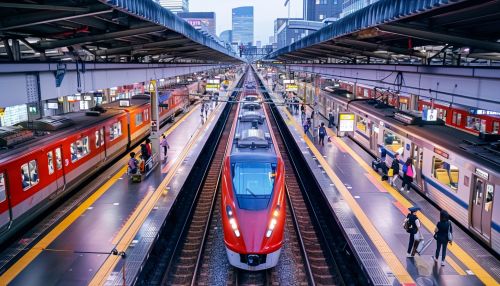Transportation in Tokyo: Difference between revisions
(Created page with "== Overview == Tokyo, the capital city of Japan, is renowned for its advanced and efficient transportation system. The city's transportation network is a complex and highly integrated system that includes various modes of transport such as railways, subways, buses, taxis, and ferries. This article delves into the intricacies of Tokyo's transportation infrastructure, examining its history, current state, and future developments. == Railways == === History === The deve...") |
No edit summary |
||
| Line 13: | Line 13: | ||
Tokyo's railway network is one of the most extensive and efficient in the world. The [[Yamanote Line]], operated by JR East, is a prominent circular line that connects major districts such as Shibuya, Shinjuku, and Ikebukuro. The [[Chuo Line (Rapid)|Chuo Line]] and the [[Keihin-Tohoku Line]] are other significant lines that facilitate intercity travel. | Tokyo's railway network is one of the most extensive and efficient in the world. The [[Yamanote Line]], operated by JR East, is a prominent circular line that connects major districts such as Shibuya, Shinjuku, and Ikebukuro. The [[Chuo Line (Rapid)|Chuo Line]] and the [[Keihin-Tohoku Line]] are other significant lines that facilitate intercity travel. | ||
[[Image:Detail-91897.jpg|thumb|center|An image of a busy railway station in Tokyo with multiple trains and passengers.|class=only_on_mobile]] | |||
[[Image:Detail-91898.jpg|thumb|center|An image of a busy railway station in Tokyo with multiple trains and passengers.|class=only_on_desktop]] | |||
=== Private Railway Companies === | === Private Railway Companies === | ||
Latest revision as of 03:41, 19 June 2024
Overview
Tokyo, the capital city of Japan, is renowned for its advanced and efficient transportation system. The city's transportation network is a complex and highly integrated system that includes various modes of transport such as railways, subways, buses, taxis, and ferries. This article delves into the intricacies of Tokyo's transportation infrastructure, examining its history, current state, and future developments.
Railways
History
The development of Tokyo's railway system began in the late 19th century. The first railway line, connecting Shimbashi and Yokohama, was inaugurated in 1872. This marked the beginning of a rapid expansion of the railway network, which played a crucial role in the city's urbanization and economic growth. The Japan Railways (JR) Group emerged as a major player in the railway sector after the privatization of the Japanese National Railways in 1987.
Current Network
Tokyo's railway network is one of the most extensive and efficient in the world. The Yamanote Line, operated by JR East, is a prominent circular line that connects major districts such as Shibuya, Shinjuku, and Ikebukuro. The Chuo Line and the Keihin-Tohoku Line are other significant lines that facilitate intercity travel.


Private Railway Companies
In addition to JR East, several private railway companies operate in Tokyo. These include Keio, Tokyu, Odakyu, and Seibu. These companies provide extensive suburban and intercity services, connecting Tokyo with neighboring prefectures.
Future Developments
The Tokyo railway network continues to evolve with ongoing projects aimed at enhancing capacity and connectivity. The Linear Chuo Shinkansen, a maglev line under construction, is expected to significantly reduce travel time between Tokyo and Nagoya. Additionally, plans for new lines and station upgrades are in place to accommodate the growing population and tourism.
Subways
History
Tokyo's subway system began with the opening of the Ginza Line in 1927. The network expanded rapidly post-World War II, with the establishment of multiple lines to cater to the city's burgeoning population.
Current Network
The Tokyo subway system comprises two main operators: Tokyo Metro and Toei Subway. Together, they operate 13 lines that cover a vast area of the city. The Hibiya Line, Marunouchi Line, and Oedo Line are some of the busiest lines, serving millions of passengers daily.
Integration with Other Modes
The subway system is well-integrated with other modes of transport, including railways and buses. Stations often serve as major hubs, facilitating seamless transfers between different lines and modes. The Suica and Pasmo cards are widely used for convenient fare payment across various transport services.
Buses
Operators
Tokyo's bus network is operated by several entities, including the Toei Bus and private companies like Keio Bus and Tokyu Bus. These buses provide essential services, particularly in areas not well-served by railways or subways.
Routes and Services
The bus routes are meticulously planned to cover residential, commercial, and industrial areas. The Toei Bus operates numerous routes within the city, while private operators focus on suburban and intercity services. Night buses and express services are also available to cater to different passenger needs.
Taxis
Fleet and Services
Tokyo's taxi fleet is extensive, with numerous companies offering services. Taxis are easily recognizable by their distinctive colors and illuminated signs. They provide a convenient mode of transport, especially for short distances and areas not well-served by public transport.
Regulations and Fares
The taxi industry in Tokyo is highly regulated to ensure safety and quality of service. Fares are standardized, with additional charges for late-night services and tolls. The Japan Federation of Hire-Taxi Associations oversees the regulation and operation of taxis in the city.
Ferries
Services and Routes
Ferries play a minor yet significant role in Tokyo's transportation network. They primarily operate in Tokyo Bay, providing scenic routes and connecting various waterfront areas. Companies like Tokyo Cruise Ship Company offer regular services, including tourist-oriented routes.
Integration with Other Modes
Ferry terminals are strategically located to facilitate easy transfers to other modes of transport. For instance, the Hinode Pier is well-connected to the Yurikamome Line, enhancing accessibility for passengers.
Future Developments
Tokyo's transportation system is continually evolving to meet the demands of its growing population and economy. Key future developments include the expansion of the railway and subway networks, the introduction of advanced technologies like autonomous vehicles, and the enhancement of existing infrastructure to improve efficiency and sustainability.
